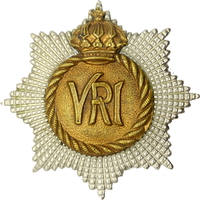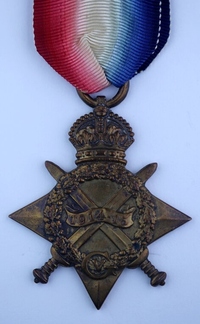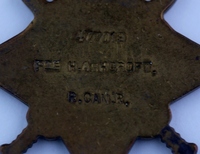
477019 Private Harold Ashcroft
The Royal Canadian Regiment
2nd Canadian Tunnelling Company
10th Battalion, Canadian Engineers
By: Capt (ret'd) Michael M. O'Leary, CD, The RCR
Harold Ashcroft was born in Lyldesley, Lancashire, England, on 22 Jul 1889. His family can be found in the 1891 census of England. Parents Thurston (31) and Sarah (29) Ashcroft are shown with four children: Annie (11), Mary (6), Henry (5), and Harold (1).
The Ashcroft family is also found in the 1901 census of England. Still living in Tyldesley, Thurston (41) and Sarah (40) have five children at home: Anne (21), Mary (16), Henry (15), Harold (11), and Nelly (9).
In 1910, at the age of 21, Harold Ashcroft left England for Canada. Sailing from Liverpool, he arrived at Halifax, Nova Scotia, aboard the S.S. Dominion of the White Star-Dominion Line and disembarked on 18 Dec 1910. Ashcroft's trade was recorded on the ship's passenger list as "miner" and it was noted that he had already worked as a miner for eight years. His intended destination in Canada was Lethbridge, Alberta.
By the time of the 1911 Canadian census, Ashcroft was living and working as a coal miner in Fernie, British Columbia. He was one of four miners who were lodgers with Mary Ann Atherton and her three children on McEvoy Street. Mary Atherton's husband, David, had died two years previously. (A comparison of maps after a 1967 change to numbered streets shows that McEvoy St. is now 8th St. in Fernie.)
Ashcroft began his First World War service on 13 Aug 1914 when he became one of the soldiers of the draft sent to Camp Valcartier by the 103rd Regiment, Calgary Rifles. His name does not appear on the Militia paylists for the 103rd Regiment in 1914, suggesting that he was a very recent enlistment, perhaps even at the outbreak of war as the unit was assembling its first draft for the call of volunteers to Camp Valcartier.
On 25 Aug 1914, Ashcroft was placed on the paylists for the 10th Canadian Infantry Battalion, one of the 1st Canadian Division units being formed at Camp Valcartier under General Sam Hughes' plan for a Canadian Expeditionary Force (C.E.F.). He would not remain with the 10th Battalion for long, soon after volunteering for what was potentially a chance at earlier overseas service. He responded to a call put out to the troops assembled at Valcartier for volunteers to form a reinforcement draft to join The Royal Canadian Regiment.
With over 30,000 men already at Camp Valcartier for the formation of the First Canadian Division of the C.E.F., the 3 Sep 1914 edition of The Toronto World described the formation of the Valcartier Draft for Bermuda:
"Four Hundred Men to Hold Bermuda
"That Many Will Be Selected at Camp to Join Regulars There.
"Rush of Volunteers.
"Nearly Thirty-Two Thousand Men Under Canvas at Valcartier.
"Canadian Press Despatch.
"VALCARTIER CAMP, Que., Sept. 2.— To bring the Royal Canadian Regiment up to war strength 400 men will be selected from this camp and immediately sent to Halifax and then to Bermuda to join the regulars there, who up to a few days ago were stationed at different points in Canada. Orders were sent out today for men, and as a result over 2000 troops gathered in front of headquarters tonight. Their names were taken, and 400 of them will be called upon to report probably tomorrow. At the early morning parade of all regiments in camp, officers requested those who wished to go to Bermuda to step out of the ranks. There was a great response. Many were ex-service men, anxious to join the regulars who, they think, will go to the front before the first contingent from Canada. It is expected that after the R.C. regiments are recruited to war strength they will be sent to France, and a battalion will be taken from Valcartier to Bermuda to relieve them."
One of the 400 men selected, Harold Ashcroft was transferred to the Bermuda Draft paylist on 4 Sep 1914. The following day, Ashcroft and other soldiers of the reinforcing draft from Valcartier were taken on the strength of The RCR. Ashcroft began his regimental service in No. 2 Provisional Company and he was given the regimental number 16101. This is the acknowledged start date of Ashcroft's First World War service. The Royal Canadian Regiment sailed for Bermuda on 11 Sep 1914 and would serve a year on garrison duty. On arriving in Bermuda on 14 Sep 1914, the Regiment relieved the 2nd Battalion, Lincolnshire Regiment, which sailed immediately for England.
The RCR reached Bermuda as a battalion comprised of its original ten companies plus four provisional companies formed from the reinforcements from Camp Valcartier. In October, 1914, a reorganization was executed. As part of this reorganization, the soldiers of the Nos. 1 and 2 Provisional Companies were reconstituted as the new "F" Company in an eight-company battalion. The Regiment would reorganize again before sailing for Europe in 1915 into a four-company organization.
Ashcroft was medically examined for active service on 30 Oct 1914 while at Prospect, Bermuda. Pronounced fit, the examination form described him as 5-feet 8-inches in height, weighing 142 1/2 pounds, with a 34-inch chest, and good physical development.
As a new soldier in a foreign station, Ashcroft was not immune to the temptations of the troubles soldiers can get themselves into. His name appears in the Regiment's Daily Order of 23 Dec 1914, when he was sentenced to 168 hours detention for disorderly conduct. Ashcroft made another appearance in the Daily Orders on 4 Jan 1915 after being sentenced to eight days Confinement to Barracks (C.B.) for "drunkenness in town."
In preparation for the Regiment's departure from Bermuda, Ashcroft was medically examined and found fit for Active Service on 14 Jul 1915.
On 12 Aug 1915, The RCR was relieved in Bermuda by the arrival of the 38th Overseas Battalion from Canada. The RCR returned to Halifax for a stay of only a week and during this time the Regiment was re-attested for overseas service. Although The RCR had just spent a year in Bermuda, there were concerns regarding the applicability of the soldiers' Permanent Force enlistments for wartime deployments. This was, perhaps, prompted by the idea that a man on a P.F. three-year engagement could choose not to re-engage and the Government would be obligated to bring him home. Enlistment in the C.E.F., on the other hand, was for the "Duration of War." Accordingly, the soldiers of The RCR were re-attested, signing C.E.F. attestation papers in August 1915 before sailing for Europe.
Ashcroft attested for service in the Canadian Expeditionary Force (C.E.F.) with The RCR at Halifax, N.S., on 23 Aug 1915. A 26-year-old miner, Ashcroft was described on his attestation paper as 5-feet 8-inches tall, with a 36-inch chest, a fair complexion, blue eyes, and yellow hair. His religious denomination was Church of England. Ashcroft identified his mother, Sarah Ashcroft, 287 Manchester Rd, Tyldesley, Lancs., Eng., as his next of kin.
The RCR sailed from Halifax on 26 Aug 1915 aboard the S.S. Caledonian, the same ship that had brought them home from Bermuda. Disembarked at Plymouth, England, on 6 Sep 1915, the Regiment went to Shorncliffe for training.
On 28 Sep 1915, Ashcroft received a new C.E.F. service number to replace the regimental number he was assigned on joining The RCR. While serving in the C.E.F., his service number would be 477019. Since the Regiment received its C.E.F. numbers while at full strength and not as they were recruited, it had the interesting effect that the soldiers of the Regiment at the time were renumbered in alphabetical order.
The RCR crossed the English Channel on 1 Nov 1915, entering the theatre of war at Boulogne, France. During November and December of 1915 the Regiment prepared for service in the trenches, with companies rotating in the lines for training and a period of providing working parties before entering the line as a battalion at the end of December. The first months of 1916 saw the Regiment in the steady rotation through front line trenches, support trenches, and reserve positions that was the fundamental experience of the infantry in the Great War.
On 20 Dec 1915, Ashcroft was admitted to the Divisional Rest Station operated by No. 4 Canadian Field Ambulance. He was suffering from influenza and, after almost a week of rest, he returned to duty on 26 Dec 1915.
After another six months of the front line soldier's cycle of experience, on 2 Jun 1916 Ashcroft was temporarily attached for duty with the 2nd Canadian Tunnelling Company. The Regiment provided a small section of ten soldiers for this task. This was the same date that the Germans assaulted Canadian lines at Mount Sorrel, capturing forward trenches which they would hold until the Canadian counter-attack on 13 June. The 2nd Cdn. Tun. Coy. reported in its War Diary the loss of over 100 killed, wounded, missing, and captured. That number included 20 attached infantry soldiers. None of the Royal Canadians were among that casualty list, suggesting they did not arrive in time to be in the forward locations where the Company was working on the 2nd of June.
It is likely that Ashcroft's skills as a miner were recognized and that he remained with the 2nd Cdn. Tun. Coy. as "Permanently Attached Infantry." On 26 Jan 1917, he and three other soldiers of the RCR were officially transferred from The RCR to the tunnelling company, his "Private" rank becoming "Sapper" with his change of Corps.
Commencing October, 1916, Ashcroft established a monthly Pay Assignment of $10 to be sent to his mother. As a Private in the C.E.F., Ashcroft was paid $1.00 per day plus an additional ten cents daily field allowance. His pay assignment represented about one-third of his monthly pay. He continued this pay assignment until his discharge in June, 1919.
Ashcroft was back in hospital on 30 Jan 1917, but no specifics are noted in his records. It was possibly a bout of influenza or trench fever, or possibly another period of rest for him. He rejoined 2 Cdn. Tun. Coy. from hospital on 10 Feb 1917.
Receiving two well-earned breaks from the front during his service with the Tunnellers, Ashcroft went on leave 4-13 Jun 1917 and again on 3-17 Feb 1918.
The 2nd Cdn. Tun. Coy was disbanded on 6 Jul 1918. The Company's War Diary notes that "Personnel [were] divided into six parts and posted to 1st, 2nd, 3rd, 10th, 11th, [and] 12th Battalions, Canadian Engineers." Ashcroft was struck off strength of the 2nd Cdn. Tun. Coy. to 10th Battalion, Canadian Engineers. The 10th Battalion's War Diary noted the increase of two Officers and 88 Other Ranks from the 2nd Tunnelling Company.
On 3 Sep 1918, Ashcroft was wounded in action and evacuated to the Field Ambulance. The 10th Bn., C.E., War Diary entry for the day notes a single Other Rank wounded that date. It offers no further details.
Two days after his wounding, on 5 Sep 1918 Ashcroft was admitted to 54 General Hospital. His wounds were noted as "shot wound, head, left abdomen." Evacuated to England aboard the hospital transport ship H.S. Pieter de Conick, Ashcroft was struck off the strength of the battalion and posted to the Canadian Engineer Reinforcement Depot (C.E.R.D.) at Seaford. Soldiers who were evacuated from the continent to England were posted to their unit's affiliated Depot as their parent unit until they were fit to return to the front.
On 8 Sep 1918, Ashcroft was admitted to 1st Eastern General Hospital at Cambridge. His case notes identify his wounds as "G.S.W. head, buttock and leg." He was transferred to the Malton Convalescent Hospital at Woodcote Park, Epsom, on 6 Nov 1918. With a week, on 12 Nov 1918, Ashcroft's case notes stated "Wound healed, heart and lungs neg., no evidence of disability, [fit, category] A."
Two weeks later, on 27 Nov 1918, Ashcroft was discharged from M.C.H. Epsom with the notation "Wound healed, no evidence of disability." Returning to duty, he was struck off the strength of the C.E.R.D. and posted to the 2nd Canadian Engineer Reserve Battalion (C.E.R.B.)
Soon after getting out of hospital, Ashcroft was granted a sick furlough from 27 Nov to 7 Dec 1918. He went to his parent's home in Tyldesley for this leave period. Ashcroft was supposed to return to duty on 7 Dec 1918, but instead overstayed and did not report to his unit until 7 Jan 1919. This unauthorized absence led to his appearance before a District Court Martial with a charge of desertion.
The details of his Court Martial were noted in his service record as follows:
"Tried by District Court Martial, 27 Jan 1919. Charge: While on Active Service, Deserting His Majesty's Service in that he, at Seaford at 1900 o'clock, 7 Dec 1918, at which time had furlough expire failed to report to his unit, 2nd C.E.R.B., as it was his duty and remained absent until reporting to "D" Co. Orderly Room at 1100 o'clock 7 Jan 1919. Absent 30 days, 16 hours. Pleaded Not guilty. Finding: Not guilty of Desertion but guilty of A.W.L. Sentence: The court sentenced the accused to undergo detention for 42 days, 27 Jan 1919. Forfeits 21 days pay. Confirmed by H.M. Dyer, Brig. Gen. Commanding Canadians, Seaford, 27 Jan 1919. Promulgated at Seaford, 31 Jan 1919. Court of Inquiry held on 30 Dec 1918 but never reported back before finding was reached. D.O. 139. In Arrest 7 Jan 1919."
On 28 Jan 1919, about the time that Ashcroft was on his way to military prison, he was also struck off the strength of 2nd C.E.R.B. to 1st C.E.R.B.
Ashcroft served his sentence at the Detention Barracks at Wandsworth. He returned from Wandsworth after being granted 7 days remission of sentence of 42 days awarded by DCM. For his absence and the time he spent in cells, Ashcroft forfeited a total of 94 days' pay.
On 3 Jun 1919, Ashcroft was posted from 1st C.E.R.B. to the C.E.R.D. on proceeding to No. 2 Canadian Discharge Depot (C.D.D.) at London. That same date, he was discharged in the United Kingdom.
For his service in the C.E.F., Ashcroft was entitled to receive the 1914-15 Star, the British War Medal, and the Victory Medal. These were despatched to him at 21 Clarence Ave., Doncaster, Yorkshire, Eng., in 1921.
Pro Patria
Visit a randomly selected page in The O'Leary Collection (or reload for another choice):
- The O'Leary Collection; Medals of The Royal Canadian Regiment.
- Researching Canadian Soldiers of the First World War
- Researching The Royal Canadian Regiment
- The RCR in the First World War
- Badges of The RCR
- The Senior Subaltern
- The Minute Book (blog)
- Rogue Papers
- Tactical Primers
- The Regimental Library
- Battle Honours
- Perpetuation of the CEF
- A Miscellany
- Quotes
- The Frontenac Times
- Site Map
QUICK LINKS
The O'Leary Collection—Medals of The Royal Canadian Regiment
Newest additions:
![]()
![]() SB-12725 Private Henry "Hank" Ard
SB-12725 Private Henry "Hank" Ard ![]()
WIA at Hill 187, Died of Wounds in Japan
![]()
![]() 2355331 Lance Corporal Albert Lorking
2355331 Lance Corporal Albert Lorking
Wounded in action, later a War Amps representative.
![]()
![]() 4334 / 477996 Pte Isaac Hamilton Wilcox
4334 / 477996 Pte Isaac Hamilton Wilcox
Permanent Force, South Africa, and C.E.F.
![]()
![]() 477019 Private Harold Ashcroft
477019 Private Harold Ashcroft
Transferred to the Tunnelers.
![]()
![]() 734231 Private Clark D. Thompson
734231 Private Clark D. Thompson ![]()
The older Thompson brother, killed in action.
![]()
![]() 733849 Private Norman Parker Thompson
733849 Private Norman Parker Thompson
The younger Thompson brother; post-war service in the Special Guard.
![]()
![]()
![]() A305 / 400305 Private Andrew Walker
A305 / 400305 Private Andrew Walker ![]()
"Previously reported Wounded, now Killed in Action."
![]()
![]() 823298 Pte Thomas Patrick Steele, M.M.
823298 Pte Thomas Patrick Steele, M.M. ![]()
… for gallant conduct in the field …
![]()
![]() P13066 Sergeant Harold Thompson
P13066 Sergeant Harold Thompson
Instrumental Soloist for over 20 years of Canadian Army service.
![]()
![]() 9609 / 477728 Private Albert Edward Piper
9609 / 477728 Private Albert Edward Piper
"Arrived from England as a STOWAWAY …"




